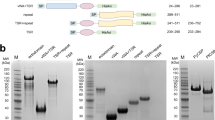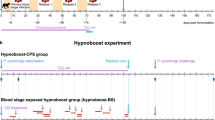Abstract
Malaria infection starts when mosquitoes inject sporozoites into the skin. The parasites enter the blood stream and make their way to the liver where they develop into the exo-erythrocytic forms (EEFs). Immunization with irradiated sporozoites (IrSp) leads to robust protection against malaria infection in rodents1, monkeys2 and humans3 by eliciting antibodies to circumsporozoite protein (CS) that inhibit sporozoite infectivity, and T cells that destroy the EEFs4. To study the role of non-CS antigens in protection, we produced CS transgenic mice that were tolerant to CS T-cell epitopes. Here we show that in the absence of T-cell-dependent immune responses to CS, protection induced by immunization with two doses of IrSp was greatly reduced. Thus, although hundreds of other Plasmodium genes are expressed in sporozoites5 and EEFs6, CS is a dominant protective antigen. Nevertheless, sterile immunity could be obtained by immunization of CS transgenics with three doses of IrSp.
This is a preview of subscription content, access via your institution
Access options
Subscribe to this journal
Receive 51 print issues and online access
$199.00 per year
only $3.90 per issue
Buy this article
- Purchase on Springer Link
- Instant access to full article PDF
Prices may be subject to local taxes which are calculated during checkout





Similar content being viewed by others
References
Nussenzweig, R. S., Vanderberg, J., Most, H. & Orton, C. Protective immunity produced by the injection of x-irradiated sporozoites of Plasmodium berghei. Nature 216, 160–162 (1967)
Gwadz, R. W., Cochrane, A. H., Nussenzweig, V. & Nussenzweig, R. S. Preliminary studies on vaccination of rhesus monkeys with irradiated sporozoites of Plasmodium knowlesi and characterization of surface antigens of these parasites. Bull. World Health Organ. 57, (Suppl 1)165–173 (1979)
Clyde, D. F., Most, H., McCarthy, V. C. & Vanderberg, J. P. Immunization of man against sporozoite-induced falciparum malaria. Am. J. Med. Sci. 266, 169–177 (1973)
Romero, P. et al. Cloned cytotoxic T cells recognize an epitope in the circumsporozoite protein and protect against malaria. Nature 341, 323–326 (1989)
Kappe, S. H. et al. Exploring the transcriptome of the malaria sporozoite stage. Proc. Natl Acad. Sci. USA 98, 9895–9900 (2001)
Wang, Q., Brown, S., Roos, D. S., Nussenzweig, V. & Bhanot, P. Transcriptome of axenic liver stages of Plasmodium yoelii. Mol. Biochem. Parasitol. 137, 161–168 (2004)
Hoffman, S. L. et al. Protection of humans against malaria by immunization with radiation-attenuated Plasmodium falciparum sporozoites. J. Infect. Dis. 185, 1155–1164 (2002)
Hoffman, S. L. & Doolan, D. L. Malaria vaccines—targeting infected hepatocytes. Nature Med. 6, 1218–1219 (2000)
Hoffman, S. L., Rogers, W. O., Carucci, D. J. & Venter, J. C. From genomics to vaccines: malaria as a model system. Nature Med. 4, 1351–1353 (1998)
Frevert, U. et al. Malaria circumsporozoite protein binds to heparan sulfate proteoglycans associated with the surface membrane of hepatocytes. J. Exp. Med. 177, 1287–1298 (1993)
Sinnis, P. et al. Structural and functional properties of region II-plus of the malaria circumsporozoite protein. J. Exp. Med. 180, 297–306 (1994)
Wang, Q., Fujioka, H. & Nussenzweig, V. Exit of Plasmodium sporozoites from oocysts is an active process that involves the circumsporozoite protein. PLoS Pathog. 1, e9 (2005)
Tao, D. et al. Yellow fever 17D as a vaccine vector for microbial CTL epitopes: protection in a rodent malaria model. J. Exp. Med. 201, 201–209 (2005)
Schofield, L. et al. γ Interferon, CD8+ T cells and antibodies required for immunity to malaria sporozoites. Nature 330, 664–666 (1987)
Weiss, W. R., Good, M. F., Hollingdale, M. R., Miller, L. H. & Berzofsky, J. A. Genetic control of immunity to Plasmodium yoelii sporozoites. J. Immunol. 143, 4263–4266 (1989)
Mueller, A. K., Labaied, M., Kappe, S. H. & Matuschewski, K. Genetically modified Plasmodium parasites as a protective experimental malaria vaccine. Nature 433, 164–167 (2005)
Mueller, A. K. et al. Plasmodium liver stage developmental arrest by depletion of a protein at the parasite–host interface. Proc. Natl Acad. Sci. USA 102, 3022–3027 (2005)
van Dijk, M. R. et al. Genetically attenuated, P36p-deficient malarial sporozoites induce protective immunity and apoptosis of infected liver cells. Proc. Natl Acad. Sci. USA 102, 12194–12199 (2005)
Marti, M., Good, R. T., Rug, M., Knuepfer, E. & Cowman, A. F. Targeting malaria virulence and remodeling proteins to the host erythrocyte. Science 306, 1930–1933 (2004)
Hiller, N. L. et al. A host-targeting signal in virulence proteins reveals a secretome in malarial infection. Science 306, 1934–1937 (2004)
Mota, M. M. et al. Migration of Plasmodium sporozoites through cells before infection. Science 291, 141–144 (2001)
Wizel, B. et al. Irradiated sporozoite vaccine induces HLA-B8-restricted cytotoxic T lymphocyte responses against two overlapping epitopes of the Plasmodium falciparum sporozoite surface protein 2. J. Exp. Med. 182, 1435–1445 (1995)
Robson, K. J. et al. A highly conserved amino-acid sequence in thrombospondin, properdin and in proteins from sporozoites and blood stages of a human malaria parasite. Nature 335, 79–82 (1988)
Sultan, A. A. et al. TRAP is necessary for gliding motility and infectivity of plasmodium sporozoites. Cell 90, 511–522 (1997)
Frevert, U. et al. Intravital observation of Plasmodium berghei sporozoite infection of the liver. PLoS Biol. 3, e192 (2005)
Alonso, P. L. et al. Duration of protection with RTS, S/AS02A malaria vaccine in prevention of Plasmodium falciparum disease in Mozambican children: single-blind extended follow-up of a randomised controlled trial. Lancet 366, 2012–2018 (2005)
Reece, W. H. et al. A CD4+ T-cell immune response to a conserved epitope in the circumsporozoite protein correlates with protection from natural Plasmodium falciparum infection and disease. Nature Med. 10, 406–410 (2004)
Sano, G., Morimatsu, K. & Horii, T. Purification and characterization of dihydrofolate reductase of Plasmodium falciparum expressed by a synthetic gene in Escherichia coli. Mol. Biochem. Parasitol. 63, 265–273 (1994)
Bruna-Romero, O. et al. Detection of malaria liver-stages in mice infected through the bite of a single Anopheles mosquito using a highly sensitive real-time PCR. Int. J. Parasitol. 31, 1499–1502 (2001)
Carvalho, L. H., Hafalla, J. C. & Zavala, F. ELISPOT assay to measure antigen-specific murine CD8+ T cell responses. J. Immunol. Methods 252, 207–218 (2001)
Acknowledgements
V.N. is supported by the Gates Foundation, R.S.N by the Starr Foundation, F.Z. by the NIH, and M.C.N. is a Howard Hughes Investigator. We thank A. Nussenzweig for suggestions. S.B. is supported by the Pew Foundation.
Author information
Authors and Affiliations
Corresponding author
Ethics declarations
Competing interests
Reprints and permissions information is available at www.nature.com/reprints. The authors declare no competing financial interests.
Supplementary information
Supplementary Methods
The file contains Supplementary Methods which include the experimental details that have not been elaborated in the main text of the manuscript and Supplementary Figures 1-5 and legends (PDF 3713 kb)
Rights and permissions
About this article
Cite this article
Arun Kumar, K., Sano, Gi., Boscardin, S. et al. The circumsporozoite protein is an immunodominant protective antigen in irradiated sporozoites. Nature 444, 937–940 (2006). https://doi.org/10.1038/nature05361
Received:
Accepted:
Published:
Issue Date:
DOI: https://doi.org/10.1038/nature05361
This article is cited by
-
Accelerated prime-and-trap vaccine regimen in mice using repRNA-based CSP malaria vaccine
npj Vaccines (2024)
-
Malaria oocysts require circumsporozoite protein to evade mosquito immunity
Nature Communications (2022)
-
A public antibody lineage that potently inhibits malaria infection through dual binding to the circumsporozoite protein
Nature Medicine (2018)
-
Malaria prevention: from immunological concepts to effective vaccines and protective antibodies
Nature Immunology (2018)
-
A Plasmodium berghei sporozoite-based vaccination platform against human malaria
npj Vaccines (2018)
Comments
By submitting a comment you agree to abide by our Terms and Community Guidelines. If you find something abusive or that does not comply with our terms or guidelines please flag it as inappropriate.



